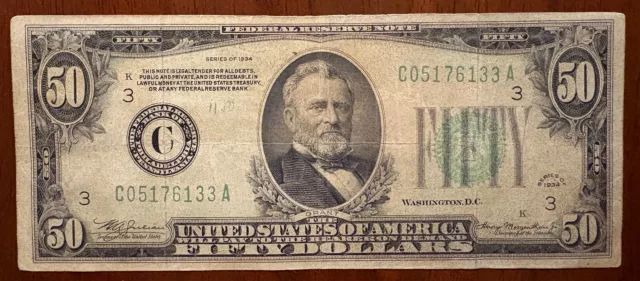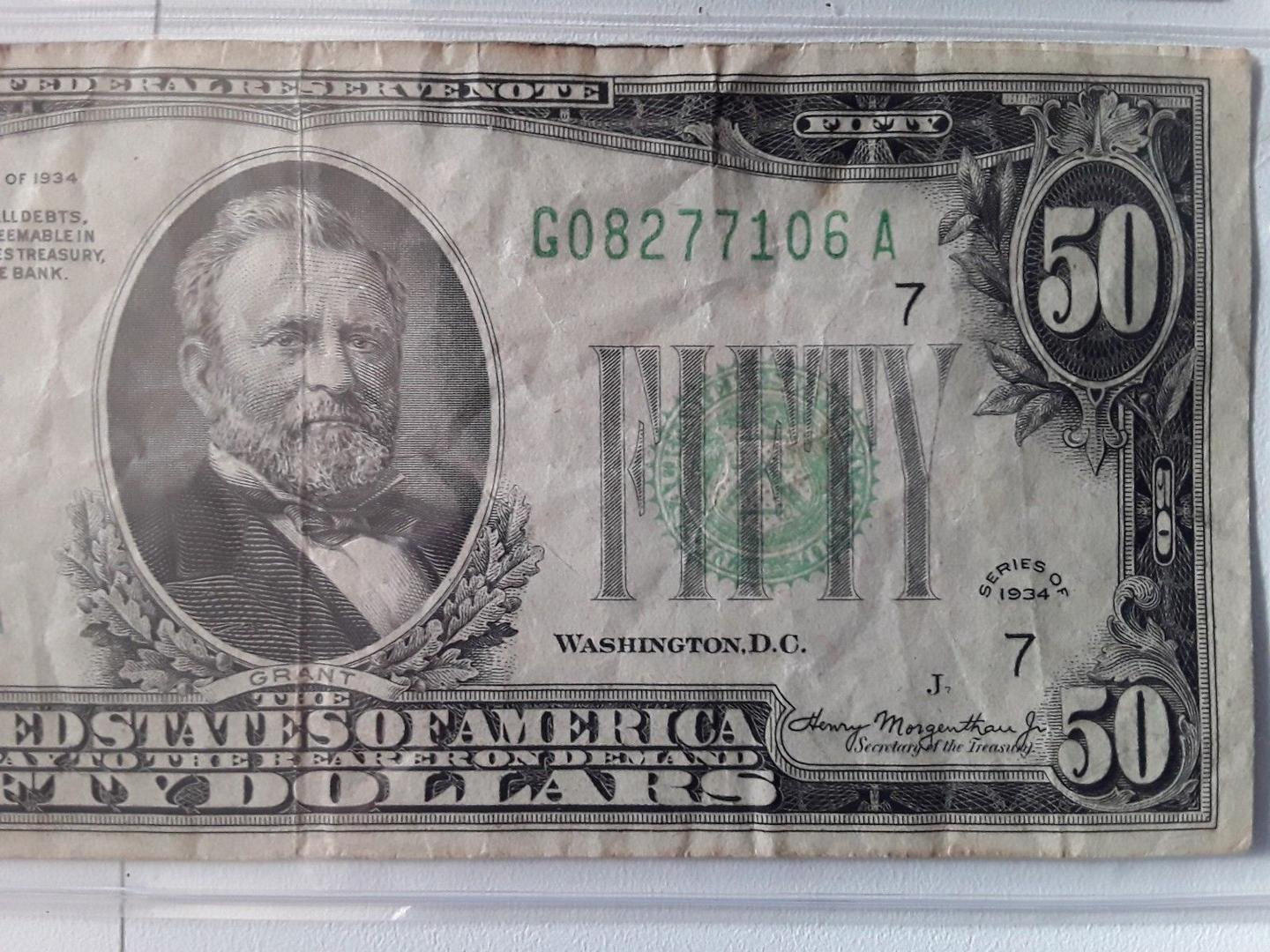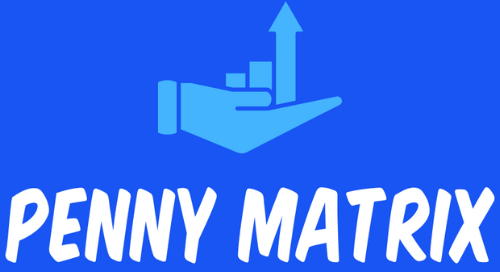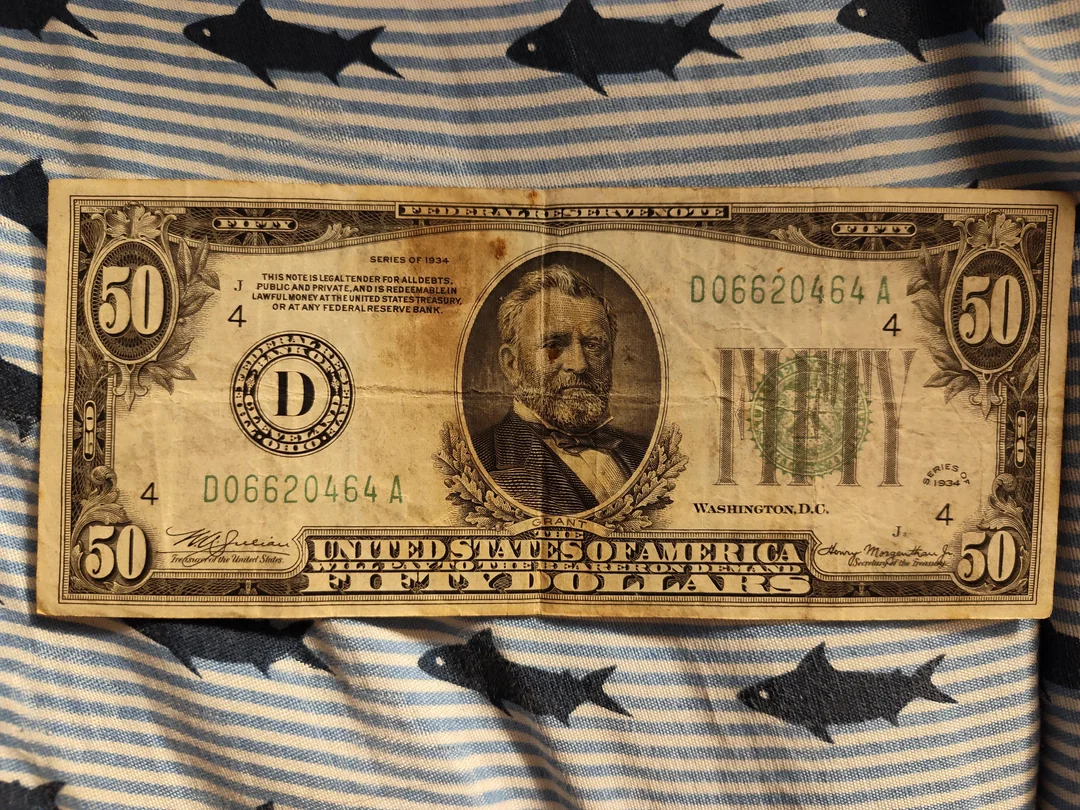When it comes to collecting U.S. currency, the 1934 50 dollar bill is one of the most sought-after notes for enthusiasts and investors alike. As a fifty dollar bill in the 1934 series, it holds significant historical value, and depending on the specific version and condition, it can fetch a high price in the market.
This article will delve into the details of the 1934 50 dollar bill, exploring its value, the differences in series, how to identify error notes, and the appeal of star notes.

Understanding these aspects is key to evaluating whether your $50 bill is a hidden gem or a piece of historical significance.
Overview Of The 1934 50 Dollar Bill
The 1934 fifty dollar bill was part of the Federal Reserve Notes series. The most notable feature of the bill is its portrait of Ulysses S. Grant, the 18th President of the United States.
The design also includes a depiction of the United States Capitol on the reverse side. The 1934 series was part of a larger transition in U.S. currency, marking the end of the gold standard in the United States.
One of the key details of the 1934 50 dollar bill is the absence of the phrase “redeemable in gold,” which was a standard feature on U.S. bills prior to this time.
The 1934 $50 bill was issued in multiple sub-series: 1934, 1934A, 1934B, 1934C, and 1934D. Each of these series represents a slightly different printing, and each series can have different values, which is important to collectors.
Understanding these variations and their conditions is essential for anyone looking to evaluate the worth of a fifty dollar bill from 1934.
The Value Of The 1934 50 Dollar Bill
The value of a 1934 50 dollar bill can range widely depending on its condition, rarity, and specific series. As with most collectible currency, the value is directly tied to its condition.

Notes in better condition, such as those that are uncirculated or have a choice uncirculated grade, will fetch a higher price than those in circulated condition. Additionally, the series in question plays a significant role in determining the price.
Series Breakdown
- 1934 Series: A standard 1934 $50 bill in very fine condition is typically worth between $65 and $70. However, if the note is in MS 63 uncirculated condition, the price can rise to $235.
- 1934A Series: This series holds slightly more value, with very fine notes worth around $80 to $95, and uncirculated notes reaching $275 to $300.
- 1934B Series: The 1934B $50 bill is more valuable, especially in uncirculated condition, with prices ranging from $80 to $85 in very fine condition and reaching as high as $350 to $400 for MS 63 uncirculated notes.
- 1934C Series: For this series, the 1934C $50 bill can be worth $90 to $110 in very fine condition, but only around $200 for uncirculated notes.
- 1934D Series: The 1934D notes are generally valued between $75 to $90 in very fine condition, with uncirculated versions typically priced between $200 and $235.
It is crucial to remember that the market for currency is highly variable, and factors such as demand, the overall state of the economy, and the appeal of specific notes can influence pricing.
The Role Of Star Notes in 1934 Series
One of the most coveted variations of the 1934 fifty dollar bill is the star note. Star notes are replacement bills that the Federal Reserve printed when a standard bill was damaged or misprinted during the printing process.
These notes are much rarer than regular bills, and their scarcity makes them more valuable to collectors.
For example, a 1934 star note can significantly outstrip the value of a regular note. A star note from the 1934 series in very fine condition might be worth around $150, and in uncirculated condition, it could fetch a price as high as $600.
The 1934A star notes can command even higher prices, with very fine examples worth about $375 to $400, and uncirculated notes ranging from $1,450.
In contrast, 1934B star notes are especially rare, with very fine examples valued at $650 and uncirculated notes reaching $3,000 in value.
Star notes from certain Federal Reserve districts are also more valuable. Notes issued from the Federal Reserve Banks of Cleveland, Dallas, and Minneapolis tend to fetch higher prices, while notes from the Federal Reserve Bank of New York and a few others are typically less in demand.
The Importance Of Condition
The condition of the 1934 50 dollar bill plays a huge role in determining its value. Currency is typically graded on a scale from Good to Uncirculated, with Uncirculated bills being the most valuable.
Understanding how currency is graded is essential for collectors to properly evaluate their bills.
- Very Fine (VF): A bill that has been in circulation but is still relatively crisp, with light creases or smudges. This is the most common condition for a 1934 $50 bill.
- Choice Uncirculated (MS 63): A bill that shows no signs of wear or circulation. It retains its original crispness and is well-centered, making it much more valuable than a circulated note.
If you’re considering selling or buying a fifty dollar bill from the 1934 series, be sure to have it graded by a professional to ensure its value is properly assessed.
Error Notes and Their Value
Error notes are another intriguing aspect of the 1934 $50 bill. These are bills that were misprinted during the production process, which makes them unique and highly collectible.
Error notes can come in various forms, such as misaligned printing, wrong serial numbers, or incorrect seals.
These errors often result in a 50 dollar bill being worth significantly more than a regular note, particularly if the error is rare or visually striking.
Why Collect The 1934 50 Dollar Bill?
The appeal of the 1934 50 dollar bill lies not only in its historical significance but also in its rarity, particularly when it comes to certain series and error notes.
Collectors appreciate the design featuring Ulysses S. Grant, as well as the historical context behind the currency—such as its release during the Great Depression, the withdrawal from the gold standard, and the ongoing changes in U.S. monetary policy at the time.
For investors, the 1934 $50 bill offers a relatively affordable way to enter the world of currency collecting. While some notes from the series can be quite valuable, even a 1934 50 dollar bill in circulated condition can be a solid addition to a collection.
The fact that these bills are still relatively accessible compared to other more expensive currencies makes them an attractive option for new and seasoned collectors alike.
Conclusion
The 1934 50 dollar bill is a fascinating piece of American history that holds significant value for collectors. The value of the bill depends on the series, the condition, and the presence of any unique features like star notes or error notes.
Looking to add a 50 dollar bill to your collection or are interested in understanding its market value, it’s important to keep in mind that currency collecting is an ever-evolving field, and prices fluctuate based on demand and rarity.
If you’re lucky enough to have a 1934 fifty dollar bill, especially one in uncirculated or star note condition, you may have a valuable piece of currency on your hands. However, regardless of its specific value, the 1934 50 dollar bill remains an iconic symbol of U.S. currency and an essential item for any serious collector.

